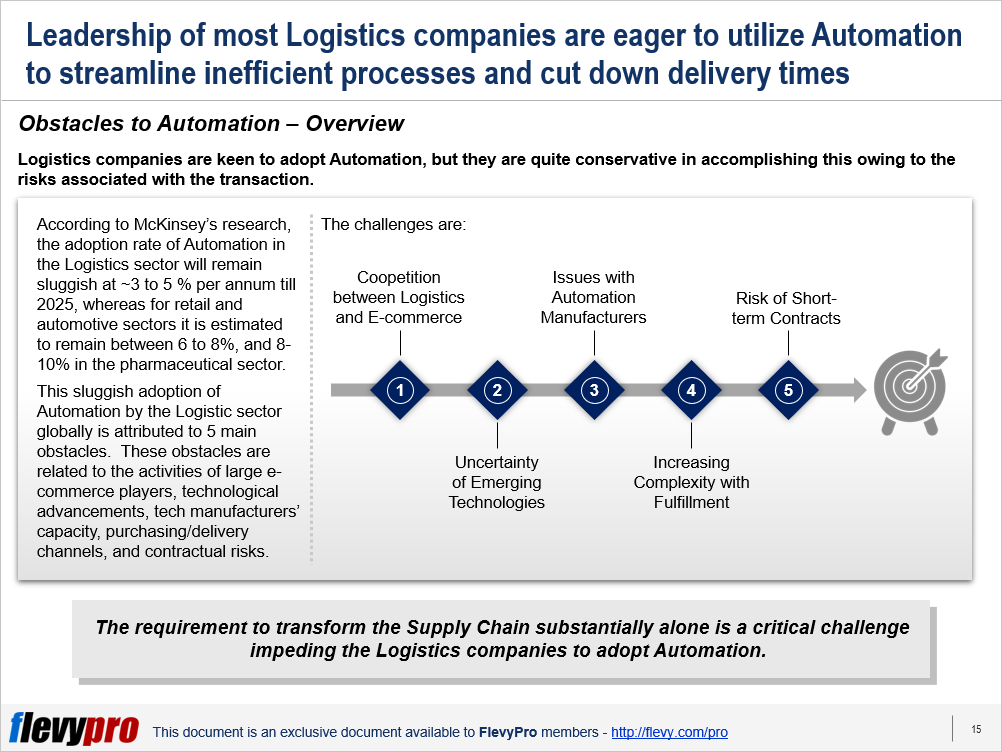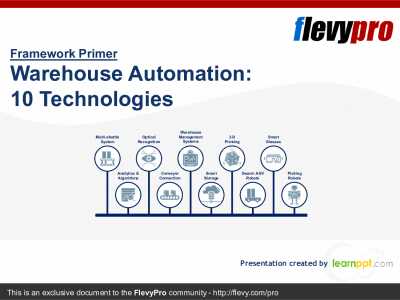Editor's Note: Take a look at our featured best practice, Logistics and Transportation Value Chain (31-slide PowerPoint presentation). An Industry Value Chain is a visual representation of the series of steps an organization in a specific industry takes to deliver a product or service to the market. It captures the main business functions and processes that are involved in delivering the end product or service, illustrating how [read more]
Also, if you are interested in becoming an expert on Supply Chain Management (SCM), take a look at Flevy's Supply Chain Management (SCM) Frameworks offering here. This is a curated collection of best practice frameworks based on the thought leadership of leading consulting firms, academics, and recognized subject matter experts. By learning and applying these concepts, you can you stay ahead of the curve. Full details here.
* * * *

Digital Transformation has propelled technologies and innovation in Logistics. Artificial Intelligence is taking charge of a number of repetitive logistics tasks. Organizations are benefiting from Automation in streamlining their cumbersome processes and cutting down delivery times.
Automation is profoundly affecting the way Logistics are handled. It is disrupting the entire Logistics Supply Chain, not just the warehousing, picking, and sorting functions. The impact of Automation on roads, rails, and ports is immense. Ports are increasingly embracing Automation, but they haven’t yet started getting the return on their investments.
In Logistics, ocean and air shipment has potential for Automation—which is certainly under way—but its effect on enhancing throughput is yet to be seen. Logistics operations are being transformed at quite a pace with new models, concepts, and offerings evolving rapidly. With the current pace of technology evolution, experts believe Logistics operations would be done autonomously in the not too-distant future.
New technologies enabling Automation of the Supply Chain are continuously being evolved, with many in the pilot testing phase. However, Supply Chain businesses are largely hesitant and confused on investing in Automation. This is mainly because it is a bit unpredictable as to which potentially feasible prototypes will emerge as widespread technologies and generate positive return on investment and which ones will become obsolete within a short timeframe.
With the proliferation of E-commerce and worsening shortage of labor due to the pandemic, Automation is being viewed by many Logistics companies to be the only option to prepare for the future. However, they are quite conservative in accomplishing this owing to the risks associated with the transaction.
According to McKinsey’s research, the adoption rate of Automation in the Logistics sector will remain sluggish at ~3 to 5% annually till 2025. Such a slow rate of uptake for Automation by the Logistic sector globally is attributed to 5 main obstacles.
- Coopetition between Logistics and E-commerce
- Uncertainty of Emerging Technologies
- Issues with Automation Manufacturers
- Increasing Complexity with Fulfillment
- Risk of Short-term Contracts

Let’s talk about these obstacles in detail.
Coopetition between Logistics and E-commerce
The growth of the online retail sector is quite lucrative for Logistics companies. However, the unusual dynamics between the online retailers and Logistics companies cause some critical challenges for the latter, including:
- To gain a sizable share in this market, Logistics firms need to have 2 critical competencies: speed and variety. These 2 competencies often become a major shortcoming for the Logistics operators—e.g., managing delivery of thousands of products out of a multitude of SKUs daily (on same-day delivery term).
- Excess buying power of online retailers allows them to switch from one logistic operator to the other if they do not fancy their offer. This keeps the rates, revenues, and returns on Automation investment low for logistics companies.
- Large e-commerce retailers (e.g., Amazon) have their own Logistics units, allowing them to offer white-label products, which further shadows the offerings of Logistics companies.
- Large online retailers can easily establish warehouses in far-off areas, in addition to, offering instant and same-day delivery services—which isn’t straightforward for Logistics companies.
- Large online retailers have seasonal demand shifts—highest during Valentine’s Day or Christmas. To serve e-tailers during seasonal peaks, Logistics companies need to maintain excess capacity at all times, which isn’t affordable for many Logistics firms.
Uncertainty of Emerging Technologies
The unpredictable impact and future of the Logistics Automation technology is another major obstacle in its acceptance and implementation.
Interested in learning more about the other obstacles and challenges in the adoption of Automation in the Logistics sector? You can download an editable PowerPoint presentation on 5 Obstacles Hampering Logistics Automation here on the Flevy documents marketplace.
Do You Find Value in This Framework?
You can download in-depth presentations on this and hundreds of similar business frameworks from the FlevyPro Library. FlevyPro is trusted and utilized by 1000s of management consultants and corporate executives. Here’s what some have to say:
“My FlevyPro subscription provides me with the most popular frameworks and decks in demand in today’s market. They not only augment my existing consulting and coaching offerings and delivery, but also keep me abreast of the latest trends, inspire new products and service offerings for my practice, and educate me in a fraction of the time and money of other solutions. I strongly recommend FlevyPro to any consultant serious about success.”
– Bill Branson, Founder at Strategic Business Architects
“As a niche strategic consulting firm, Flevy and FlevyPro frameworks and documents are an on-going reference to help us structure our findings and recommendations to our clients as well as improve their clarity, strength, and visual power. For us, it is an invaluable resource to increase our impact and value.”
– David Coloma, Consulting Area Manager at Cynertia Consulting
“As a small business owner, the resource material available from FlevyPro has proven to be invaluable. The ability to search for material on demand based our project events and client requirements was great for me and proved very beneficial to my clients. Importantly, being able to easily edit and tailor the material for specific purposes helped us to make presentations, knowledge sharing, and toolkit development, which formed part of the overall program collateral. While FlevyPro contains resource material that any consultancy, project or delivery firm must have, it is an essential part of a small firm or independent consultant’s toolbox.”
– Michael Duff, Managing Director at Change Strategy (UK)

Excel workbook
This landed cost calculator is an advanced Microsoft Excel ? spreadsheet that can be used to calculate the total landed cost of importing goods into the USA
No need to waste time reinventing the wheel this spreadsheet has evolved from many years of practical use and ongoing development by a
[read more]
Want to Achieve Excellence in Supply Chain Management (SCM)?
Gain the knowledge and develop the expertise to become an expert in Supply Chain Management (SCM). Our frameworks are based on the thought leadership of leading consulting firms, academics, and recognized subject matter experts. Click here for full details.
Supply Chain Management (SCM) is the design, planning, execution, control, and monitoring of Supply Chain activities. It also captures the management of the flow of goods and services.
In February of 2020, COVID-19 disrupted—and in many cases halted—global Supply Chains, revealing just how fragile they have become. By April, many countries experienced declines of over 40% in domestic and international trade.
COVID-19 has likewise changed how Supply Chain Executives approach and think about SCM. In the pre-COVID-19 era of globalization, the objective was to be Lean and Cost-effective. In the post-COVID-19 world, companies must now focus on making their Supply Chains Resilient, Agile, and Smart. Additional trends include Digitization, Sustainability, and Manufacturing Reshoring.
Learn about our Supply Chain Management (SCM) Best Practice Frameworks here.
Readers of This Article Are Interested in These Resources

26-slide PowerPoint presentation
Shortage of labor, intensified demand from e-tailers (online retailers), and technological disruption is forcing many organizations in the Logistics and Warehousing sectors to embrace technology, particularly Automation.
Automation is facilitating Warehouse operations predominantly by
[read more]

Excel workbook
The Freight Management Worksheet is a comprehensive tool designed to provide you with full control over your logistics operations. Below is an overview of the key components of the worksheet, with a focus on each specific sheet:
1. Validation Tab
The Validation Tab ensures the accuracy and
[read more]

Excel workbook
In the intricate world of business, where every dollar counts and competition is fierce, understanding and effectively managing your total landed costs is paramount. While the initial purchase price from your supplier might seem like the final figure, it's just the tip of the iceberg. The total
[read more]

284-slide PowerPoint presentation
Unlocking Seamless Operations: Introducing the Ultimate Warehousing, Logistics, and Distribution Management Toolkit
In the fast-paced world of modern business, effective supply chain management, logistics, and distribution are pivotal to success. Every delay, mismanagement, or inefficiency can
[read more]






